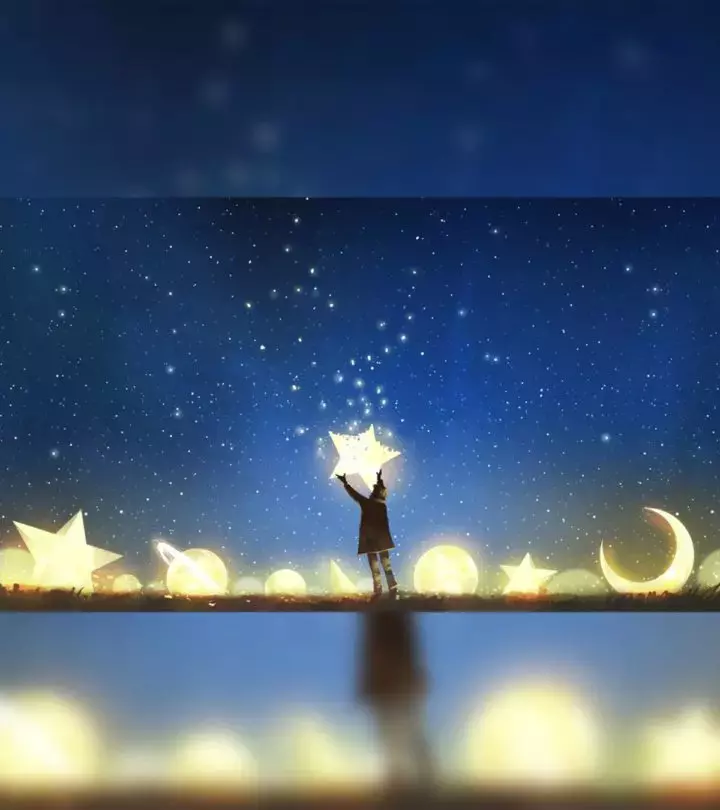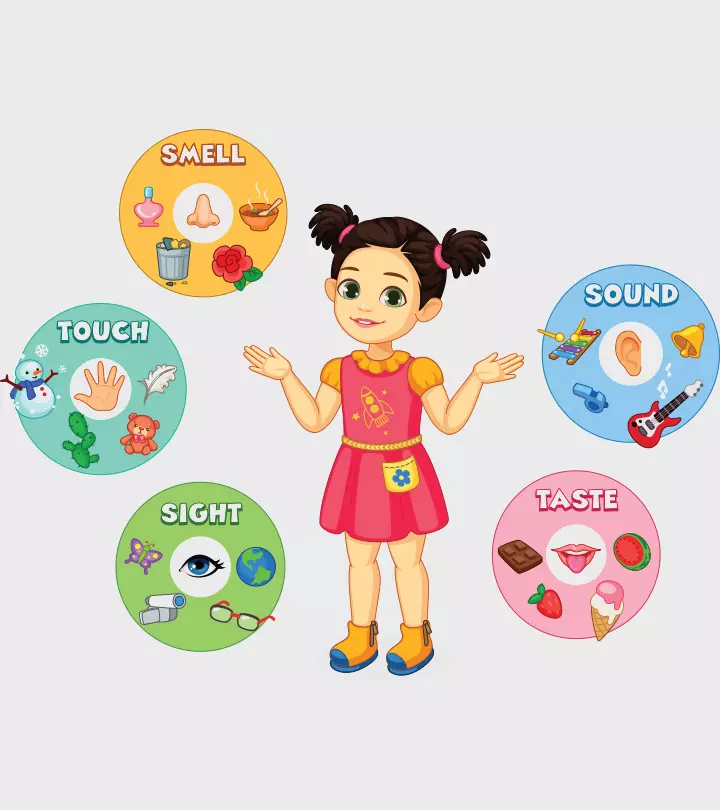
Image: iStock
Sun facts for kids may leave them amused and wondering what life is beyond the earth. The sun happens to be the closest star to the earth and looks like a never-ending entity. So if your little one wants to learn more about astronomy about the sun, temperature, distance from earth, and its abundant source of energy, here are fun science facts to fulfill their cravings. Read on.
Key Pointers
- The sun is made up of gases such as hydrogen, helium, oxygen, neon, iron, and carbon, and provides light and gravity for our solar system.
- Its core, radiative, and convective zones work in unison to transmit energy to the photosphere.
- The sun generates energy and heat by means of nuclear fusion.
- Magnetic dark spots on the sun are hotter than other areas.
- Aristarchus, Ptolemy, Copernicus, Galileo, Kepler, and Newton’s sun research provided the foundation for NASA’s further studies.
Fun Sun Facts For Children

- Without the energy of the Sun, there would be no seasons and no life on Earth. So Sun is our life-giver.
- The Sun sits at the center of our Solar System.
- The Sun sums up to 99.86% mass of the entire Solar System.
- The Sun is 74% hydrogen and 24% helium. Other elements in the Sun are carbon, oxygen, neon, and iron.
- The Sun is one of the million stars in the Galaxy.
- The sun is a dwarf star and is known as the “yellow dwarf.”
- The Sun appears to us as a huge round ball that is deep orange, because the Earth is closer to the Sun than it is to the other stars in the galaxy.
- There are other stars in the galaxy that are bigger and brighter than the Sun, or smaller than the Sun. Since they are too far from us, these stars appear as dots of light in the night sky.
 Quick fact
Quick fact- Seven planets, other than the Earth, and five dwarf planets orbit the Sun. This system is called the Solar System, which is believed to have formed around 4.6 billion years ago.
- Sun originates from the old English word Sunne or the Proto-Germanic Sunnon. In Latin, it is referred to as “Sol,” from which the word solar is derived.
- The diameter of the sun is 1.391016 million km.
- The distance between the Sun and the Earth is around 150 million km.
- The Sun’s diameter is about 109 times more than the Earth’s diameter. It weighs over 333,000 times more than our planet.
- Over 1,300,000 planets the size of earth can fit inside the Sun.
Layers of the Sun
The Sun has multiple layers through which it generates and passes on energy and light.

- The center of the Sun is called the ‘Core,’ that generates the energy of the Sun.
- The ‘Radiative Zone’ surrounds the core and transports the energy generated by the core.
- It takes around 170,000 years to transmit the energy of the Sun from its core- to the second layer, the Radiative Zone, then to the third layer which is the ‘Convective Zone.’
- Big bubbles of energy move into the Photosphere (or the surface of the Sun) via the Convective layer. Also, there is a constant flow of particles off the Sun known as solar winds (1).
- The Earth receives the sunlight when the radiation of the Sun escapes from the Photosphere.
- There two layers outside the Photosphere are the Chromosphere and the Corona. Whereas the Heliosphere is the outermost layer of the sun’s atmosphere that surrounds the sun containing solar magnetic fields (2).
 Did you know?
Did you know?- The Corona can be seen on a dull day with overcast sky or during eclipses. The solar winds are formed by the expansion of the plasma from the Corona (3).
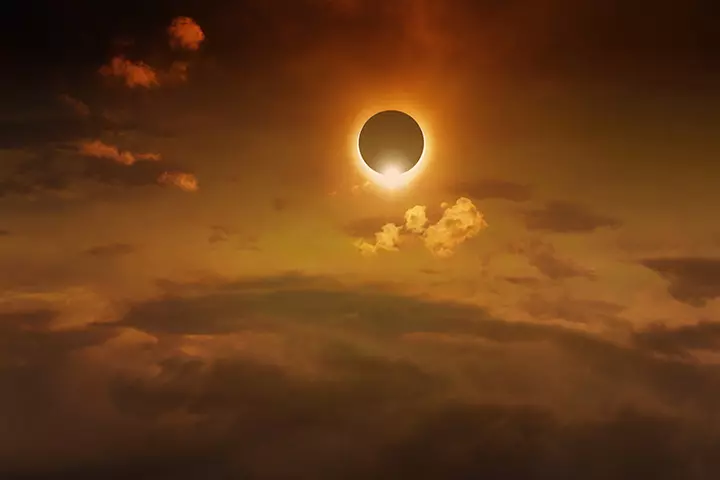
- It takes 8 minutes and 20 seconds for the Sun’s rays to reach the Earth’s atmosphere.
- The surface temperature of the Sun is approximately 5,500 degrees Celsius.
- The core temperature of the Sun is about 15 million degrees Celsius.
- The Sun’s atmosphere is hotter than its surface.
- The Sun is losing mass constantly due to nuclear fusion.
- The Sun’s magnetic field reverses approximately every 11 years.
- Around 1.3 million Earths could fit inside the Sun.
- The Sun produces energy through a process called nuclear fusion in which the hydrogen nuclei combine into helium.
- Scientists believe that the Sun’s core will run out of its energy in about 5 billion years.
- Many cultures have worshiped the Sun as God. The Egyptians called the Sun God Ra.
- The Sun is middle-aged when compared to billions of stars in the galaxy.
- The Sun’s strong gravity holds all planets in their places.
- There are some regions in the Sun where the temperature is not that strong; those spots are called ‘sun spots’. Sunspots are magnetic regions and look like dark spots on the Sun. A sudden explosion of energy near the Sunspots due to magnetic fields is known as Solar flares (4).
- Staring at the Sun directly without wearing protective glasses on a bright sunny day can damage the eye.
- During a full solar eclipse, the chromosphere can sometimes be seen as a thin, fine red line, and the corona encircling it.
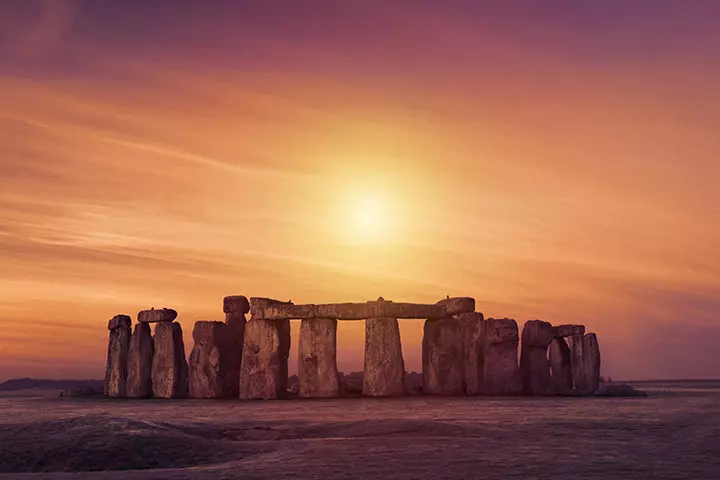
- Many believe the world-famous monument, Stonehenge, was used to worship the Sun God.
Theories of the Solar System
- Previously, it was believed that the Sun rotates around the Earth.
- Ancient Greek astronomer Aristarchus of Samos was the first to say that the planets revolved around the Sun. (c.310-c.230 BC)

- 300 years later, another astronomer Ptolemy presented his ‘Ptolemaic system’ claiming the Earth is the center of the Universe. His theory remained for the next 1400 years.

- Nicholas Copernicus, the famous Polish scientist, published his work called ’De Revolutionibus Orbium Coelestium’. He worked to establish that the planets revolved around the Sun.
- People who believed Copernicus were imprisoned and some were even executed.
- The works of famous astronomers and scientists such as Galileo and Johann Kepler reinforced the theory of Copernicus.

- Until Sir Isaac Newton published his theory of gravity, the concept of the Solar system was also not accepted entirely.
- The Sun has a specific sound. Watch this video by NASA to know how it sounds.
The Sun is a constant source of wonder to children. These easy activities will increase their curiosity about this great ball of energy.
- Simple sundial
Take a paper plate and stick a pencil through the center. This is a sundial. Place this sundial in a sunny spot and ask your child to mark the position of the shadow throughout the day.
- Sun’s layers poster
Cut circles of decreasing size from colored paper. Stack the layers on a board and glue them together. Each of these layers represents a layer of the Sun such as the core, the radiative zone, and so on.
- Solar oven
Line the inside of a pizza box with aluminum foil. Place black paper at the bottom to absorb heat. Place some marshmallows or chocolate in the box and cover with plastic wrap. Place this “oven” in sunlight. After some time, you can see the melted marshmallows or chocolate.
The sun plays a prominent role in the Earth’s seasonal changes, the occurrence of day and night, the solstice and equinox and many other naturally occurring phenomena.
Frequently Asked Questions
1. Will the sun burn out?
The sun consists mainly of hydrogen and helium and, like other stars, will burn out eventually. But scientists don’t expect the sun to burn out for the next 5 billion years or so (2).
2. Is the sun getting bigger?
At the sun’s core, hydrogen and helium are continuously heating up and collapsing, causing the outer layers of the sun to grow. However, this change is happening slowly. The sun has grown only by 20% in the last 4 billion years (3).
3. How was the sun created?
As per the sun facts, the sun was created in a cloud of gas and dust called the solar nebula nearly 4.6 billion years ago. As the dust cloud spun faster and faster, it collapsed on its own gravity and assumed a disc-like shape. The nebula’s material was pulled to the center to form the sun while the other remaining material became planets or other heavenly bodies orbiting the sun (4).
4. Does the sun move?
The sun revolves around the center of the Milky Way along with its planets, asteroids, and comets. Our solar system moves around the Milky Way at a speed of around 450,000 miles per hour or 720,000 kilometers per hour. Even with this speed, the sun takes around 230 million years to complete one rotation around the Milky Way. Besides this, the sun also revolves around its own axis (4).
5. How big is the sun?
The sun is an average-sized star in comparison to the other stars in the Milky Way. Even so, it is enormous. It has a diameter of 864,000 miles (5).
Sharing some facts about the sun for kids can increase their interest in learning more facts about the solar system. For instance, you may tell them the role and importance of the sun in the solar system and how the earth and humans benefit from sunlight. Explaining some theories about the basics of the solar system could increase your child’s interest in heliophysics. It can also be fascinating for children to know that the moon reflects the sunlight and how humans follow lunar and solar calendars.
Do you know more fun facts about the Sun? Tell us about them in the comment box below.
Infographic: Life Without The Sun
The Sun is the first component children are taught about when learning about the solar system. The center of our solar system, the Sun, is a giant ball of gas that lights up our planet and is our “day star.” But have you ever wondered what would happen if it stopped existing? This infographic will help children learn how vital the Sun is for our existence and its role in supporting life on our planet.
So save this infographic to help your children understand the Sun’s importance.
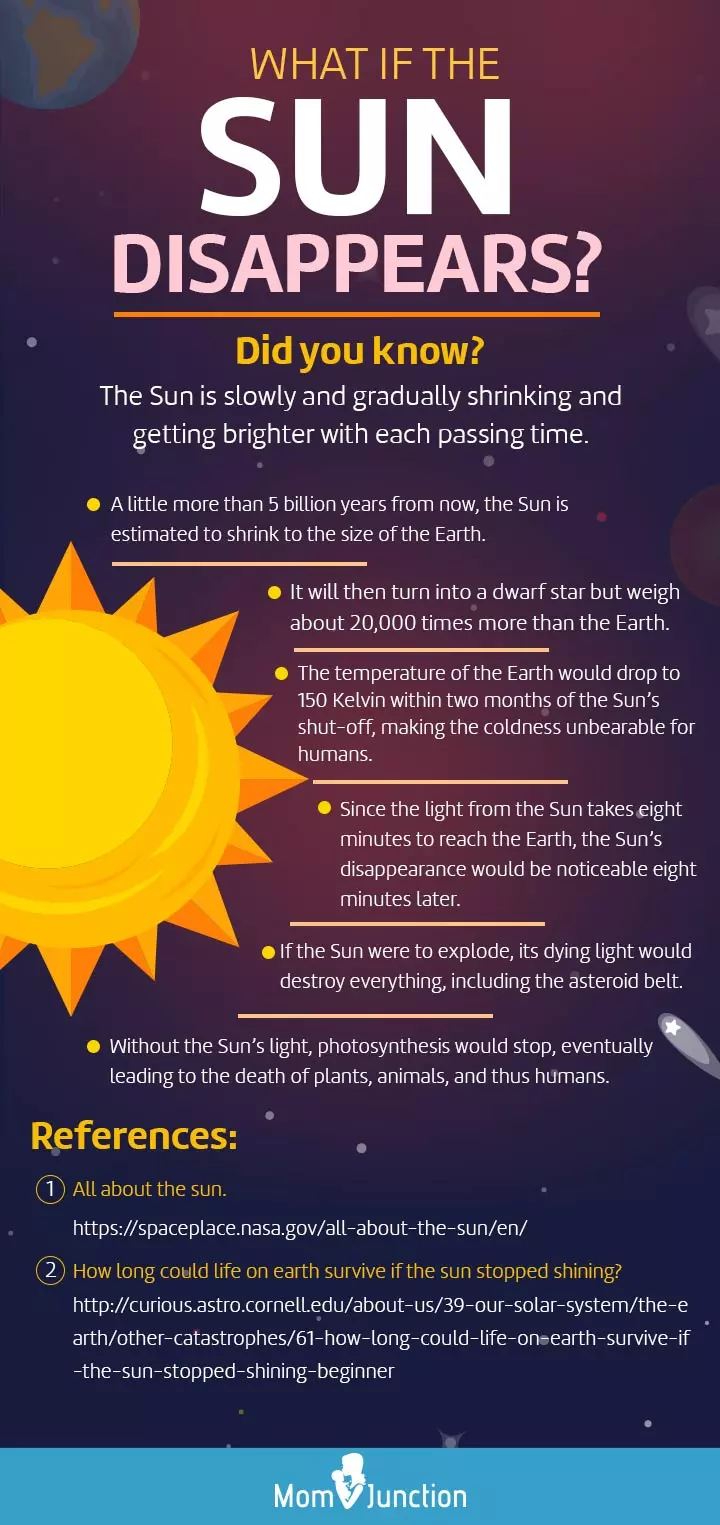
Illustration: Momjunction Design Team
Illustration: Fun And Interesting Sun Facts For Kids To Know

Image: Stable Diffusion/MomJunction Design Team
Learn all about the sun in this fun and educational video for kids! Discover its size, temperature, and how it affects our lives. Explore the mysteries of space and astronomy!
References
- Origin of the Solar System – The Nebular Hypothesis
https://geo.libretexts.org/Bookshelves/Geology/Book%3A_An_Introduction_to_Geology_(Johnson_Affolter_Inkenbrandt_and_Mosher)/08%3A_Earth_History/8.02%3A_Origin_of_the_Solar_SystemThe_Nebular_Hypothesis#12 - Sun;
https://science.nasa.gov/sun/ - How much has the size of the Sun changed in the last few billion years?;
https://education.nationalgeographic.org/resource/sun/ - Sun;
https://science.nasa.gov/sun/facts/ - How Does Our Sun Compare With Other Stars?;
https://spaceplace.nasa.gov/sun-compare/en/
Community Experiences
Join the conversation and become a part of our nurturing community! Share your stories, experiences, and insights to connect with fellow parents.
Read full bio of Elisa Yi
Read full bio of Harshita Makvana
Read full bio of Deepa Thomas
Read full bio of Praggya Joshi










